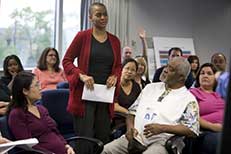Coping with a Disaster or Traumatic Event
Resources for Leaders
During a crisis, the public relies on leaders to make decisions and communicate information affecting their safety and well-being. Leaders, including government officials, leadership in non-governmental, and community organizations, and religious leaders play an important role in helping communities and individuals cope during and after a disaster. Learn how to plan for and address mental health needs before, during, and after a disaster.

Address basic safety needs first then identify and address common stress reactions.
Recognize Common Reactions to Stressful Events:
It is natural to experience stress during a disaster or traumatic event. Look for signs of stress in yourself, and members of your family and community.
- Feelings of stress, grief, fear, or anger.
- Struggle to carry out routine activities after a disaster and lack of interest in activities they usually enjoy.
- Sleep disturbances, often including nightmares and thoughts about the disaster.
- Changes in appetite, tiredness, headaches, and stomach aches.
- A need to talk, often repeatedly, about events and feelings associated with the disaster.
How to Support Coping:

Give opportunities for survivors to take action to take care of themselves and others.
- Address basic survival needs before focusing on emotional needs.
- Start supporting survivors’ ability to cope by making them more comfortable. (Take simple steps like offering a phone, handing out blankets, and distributing water)
- Expect that disaster relief assistance may be confusing to survivors. They may experience frustration, anger, and feelings of helplessness and some of these feelings may be directed toward response agencies.
- Give opportunities for survivors to take actions to help themselves and their community in response efforts.
When to Refer Someone for Professional Help
These reactions signal a need for referral to a mental health professional or to the SAMHSA helpline:
- Confusion, memory loss, inability to state the current date.
- Strong and constant feelings of sadness or strong anxiety that prevents completing regular tasks.
- Hearing voices or seeing things that are not there.
- Not regularly eating, bathing, or changing clothes or taking care of oneself.
- Thoughts or desires to harm oneself or others or becoming violent.
- Overuse of alcohol or drugs.
Tips for compassionate communication with victims of a crisis:
Through decisive, timely, and compassionate communication, leaders can greatly reduce fear and anxiety. Whether communicating directly with a person or family who is coping with a loss or addressing the wider public, leaders should:
-

Express empathy and listen carefully.
- Express empathy by acknowledging the emotions of those who are suffering.
- Listen and allow emotional expressions or crying without interruption.
- Do not answer questions outside of your expertise. Refer people to appropriate experts.
- Use the same words as the person who is speaking. For example, if they say “passed” instead of “dead,” you should also say “passed.”
- Avoid using examples from your own life and keep the focus on those currently suffering.
- Look for cues in body language and ask if they would like to be left alone.
For additional resources on communicating with populations in crisis visit the Crisis and Emergency Risk Communications (CERC) resources page. To learn more about the psychology of a crisis, read chapter 2 of the CERC Manual. For additional resources on communicating with grieving populations, see the CERC Pandemic Influenza Manual.
The six principles of CDC’s Crisis and Emergency Risk Communications (CERC) are:
- Be First: Crises are time-sensitive. Communicating information quickly is almost always important.
- Be Right: Accuracy establishes credibility.
- Be Credible: Honesty and truthfulness should not be compromised during crises.
- Express Empathy: Crises create harm, and the suffering should be acknowledged in words. Addressing what people are feeling, and the challenges they face, builds trust and rapport.
- Promote Action: Giving people meaningful things to do calms anxiety and promotes a restored sense of control.
- Show Respect: Respectful communication is particularly important when people feel vulnerable.
The Role of Leaders in Community Coping and Recovery
During a crisis, a leader may become a symbol of order. Leaders can strengthen a community during a crisis. They can:
- Empower members of the community based on their strengths.
- Give action items to empower survivors to take care of themselves and others.
- Draw upon cultural and community values to bring people together.
- Give fast and accurate updates.
- Listen to the concerns of others.
- Recognize responders’ contributions during and after a crisis. For more information on the role of leaders and community hardiness, visit the CERC Pandemic Influenza Manual.
Planning for Mental Health Services in State and Local Responses:
State and local response agencies should include mental health in all emergency preparedness and response plans.
- For more information and a sample mental health response plan for state and local government, see mental health Resources for State and Local Governments.
- Locate behavioral health treatment facilities in your state or locality to include in your plan.
When supervising or leading other responders in a crisis, take steps to ensure the well-being of responders. Crisis recovery depends on a healthy workforce.
- A guide for supervisors to help manage stress during a crisis can be found here.
- Page last reviewed: March 8, 2016
- Page last updated: November 7, 2017
- Content source:
- Maintained By:





 ShareCompartir
ShareCompartir